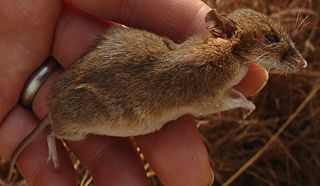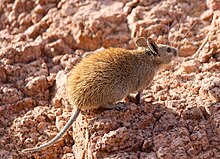
Nocturnality is an animal behavior characterized by being active during the night and sleeping during the day. The common adjective is "nocturnal", versus diurnal meaning the opposite.

Torpor is a state of decreased physiological activity in an animal, usually marked by a reduced body temperature and metabolic rate. Torpor enables animals to survive periods of reduced food availability. The term "torpor" can refer to the time a hibernator spends at low body temperature, lasting days to weeks, or it can refer to a period of low body temperature and metabolism lasting less than 24 hours, as in "daily torpor".

An endotherm is an organism that maintains its body at a metabolically favorable temperature, largely by the use of heat released by its internal bodily functions instead of relying almost purely on ambient heat. Such internally generated heat is mainly an incidental product of the animal's routine metabolism, but under conditions of excessive cold or low activity an endotherm might apply special mechanisms adapted specifically to heat production. Examples include special-function muscular exertion such as shivering, and uncoupled oxidative metabolism, such as within brown adipose tissue.

Heteromyidae is a family of rodents consisting of kangaroo rats, kangaroo mice, pocket mice and spiny pocket mice. Most heteromyids live in complex burrows within the deserts and grasslands of western North America, though species within the genus Heteromys are also found in forests and their range extends down as far as northern South America. They feed mostly on seeds and other plant parts, which they carry in their fur-lined cheek pouches to their burrows.

The subfamily Deomyinae consists of four genera of mouse-like rodents that were placed in the subfamilies Murinae and Dendromurinae until very recently. They are sometimes called the Acomyinae, particularly in references that antedate the discovery that the link rat, Deomys ferugineus, is part of the clade. Deomyinae is the older name and therefore has priority over Acomyinae.

The term spiny mouse refers to any species of rodent within the genus Acomys. Similar in appearance to mice of the genus Mus, spiny mice are small mammals with bare, scaled tails. However, their coats are endowed with unusually stiff guard hairs similar to the spines of a hedgehog; this trait is the source of the common name, spiny mouse.

Diurnality is a form of plant and animal behavior characterized by activity during daytime, with a period of sleeping or other inactivity at night. The common adjective used for daytime activity is "diurnal". The timing of activity by an animal depends on a variety of environmental factors such as the temperature, the ability to gather food by sight, the risk of predation, and the time of year. Diurnality is a cycle of activity within a 24-hour period; cyclic activities called circadian rhythms are endogenous cycles not dependent on external cues or environmental factors except for a zeitgeber. Animals active during twilight are crepuscular, those active during the night are nocturnal and animals active at sporadic times during both night and day are cathemeral.

Rudd's mouse or the white-bellied brush-furred rat is the only member of the genus Uranomys. This animal is closely related to the spiny mice, brush-furred mice, and the link rat.

Rhabdomys is a largely Southern African genus of muroid rodents slightly larger than house mice. They are known variously as striped or four-striped mice or rats. Traditionally the genus has been seen as a single species, Rhabdomys pumilio, though modern evidence on the basis of karyotype and mtDNA analysis suggests that it comprises two or more species and subspecies. Dorsally Rhabdomys species display four characteristic black longitudinal stripes on a paler background.

The Crete spiny mouse is a species of mouse endemic to Crete. It is characterized by the coarse, stiff hairs on its back and tail and a notably grayer coloration and more pointed face than other species of spiny mice. Its fur color varies from yellow to red, gray or brown on its face and back, with white fur on its underside. It is a nocturnal forager, feeding mainly on grass blades and seeds, and builds only a very rudimentary nest.
The Western Saharan spiny mouse or Aïr spiny mouse is a species of small, insectivorous rodent in the family Muridae found arid regions of western Africa.

The Cairo spiny mouse, also known as the common spiny mouse, Egyptian spiny mouse, or Arabian spiny mouse, is a nocturnal species of rodent in the family Muridae. It is found in Africa north of the Sahara, where its natural habitats are rocky areas and hot deserts. It is omnivorous and feeds on seeds, desert plants, snails, and insects. It is a gregarious animal and lives in small family groups. It is the first and only known rodent species that exhibit spontaneous decidualization and menstruation.

The Asia Minor spiny mouse is a species of rodent in the family Muridae.
The fiery spiny mouse is a species of rodent in the family Muridae found in Kenya and Tanzania. Its natural habitats are dry savanna and rocky areas. It may be found as a commensal in human habitations.
Kemp's spiny mouse is a species of rodent in the family Muridae. It is found in Kenya, Somalia, and Tanzania. Its natural habitats are dry savanna and rocky areas. It is one of only two mammals, the other being Acomys percivali, which can shed its skin. In addition, it is known to be capable of completely regenerating damaged tissue, including hair follicles, skin, sweat glands, fur and cartilage.

The Cape spiny mouse is a murid rodent found in the Western Cape province of South Africa. They have a dorsal covering of spiny hairs with dark grey-brown colouration, and a white underbelly. The Cape spiny mouse has large eyes and ears and a scaly, nearly bald tail that is brittle and can break off readily either as a whole or in part if it is caught. Their total length is 17 cm (6.7 in), with an 8 cm (3.1 in) tail, and they typically weigh 22 g (0.78 oz).
Wilson's spiny mouse is a species of rodent in the family Muridae. It is found in Ethiopia, Kenya, Somalia, South Sudan, Tanzania, and Uganda. Its natural habitats are dry savanna, subtropical or tropical dry shrubland, and rocky areas.Molecular evidence suggests that spiny mice (Acomys) are genetically more closely related to gerbils (Gerbillinae) than they are to actual mice (Muridae) based on their murine morphology.

The eastern spiny mouse or Arabian spiny mouse is a species of rodent in the family Muridae. They have a wide range, having been found in Middle Eastern deserts, as well as being prevalent in riverine forests in Africa. This is the only species of spiny mouse which may have black coloration. Their diet is similar to other species of spiny mouse, consisting mostly of seeds.
Flexible or opportunistic breeders mate whenever the conditions of their environment become favorable. Their ability and motivation to mate are primarily independent of day-length (photoperiod) and instead rely on cues from short-term changes in local conditions like rainfall, food abundance and temperature. Another factor is the presence of suitable breeding sites, which may only form with heavy rain or other environmental changes.















